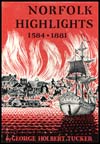Chapter 15
Streets Where History Walked
Despite the drastic face-lifting that downtown Norfolk has undergone during the last few years, it still retains enough of its pre-Revolutionary street names to link it with its earliest history.
Of these, Main Street and Church Street (the lower part of the latter now being known as St. Paul's Boulevard) are the oldest.
Main Street, laid out between 1680 and 1681 by John Ferebee, the Lower Norfolk County surveyor when the town was established, extended from Four Farthing Point (later Town Point) to Dun-in-the-Mire Creek (later Newton's Creek) in the east. Its original zigzag shape, now considerably truncated, followed the high ground between creek branches.
Church Street, first known as "the street that leadeth into the woods" and later as "the street that leadeth out of town," originally crossed a natural causeway connecting the land on which the town was first laid out and the country to the north of Town Back Creek and Dun-in-the-Mire Creek. It was later called Church Street because the Norfolk Borough Church, now St. Paul's Episcopal Church, stood on its west side.
Norfolk's first notable real estate boom took place in the early 1760s when Gershom Nimmo surveyed the extensive property holdings of Samuel Boush III north of Town Back Creek. It was at that time that many downtown Norfolk streets received their present names. These are:
- Boush Street, named for Samuel Boush III, the owner of the land.
- Granby Street, named for John Manners (1721-1770), Marquis of Granby, a popular military hero of the Seven Years War.
- Cumberland Street, named for William Augustus, Duke of Cumberland (1721-1765), the uncle of George III who defeated Prince Charles Edward Stuart (the Young Pretender, popularly called Bonnie Prince Charlie) and his Jacobite forces at Culloden Moor, Scotland, in 1746.
- Charlotte Street, named for Princess Charlotte Sophia of Mecklenburg-Strelitz, who married King George III in 1761.
- Freemason Street, so called because the Norfolk Royal Exchange Lodge of Masons erected the "Mason's Hall" on a lot on the southeast corner of Freemason and Cumberland streets bought by them on July 11, 1764. The Willoughby-Baylor House now stands on that site.
- Bute Street, named for John Stuart, Third Earl of Bute (1713-1792), a Scottish favorite of George III, and British prime minister from 1762 to 1763. He is principally remembered today because he granted Dr. Samuel Johnson, whom James Boswell immortalized in his famous biography, a pension of three hundred pounds a year.
Other old Norfolk streets that still retain their pre-Revolutionary names are Fenchurch, York, Duke, Yarmouth, Dunmore, and Botetourt streets, but the origins of their names, except for the last two, are obscure.
Dunmore Street was named for John Murray, Fourth Earl of Dunmore (1732-1809), governor of Virginia from 1771 to 1775. Dunmore began the destruction of pre-Revolutionary Norfolk on January 1, 1776, when his ships opened fire on the town.
Botetourt Street takes its name from Norborne Berkeley, Baron de Botetourt (1718-1770), Colonial governor of Virginia from 1768 to 1770.
One other Norfolk thoroughfare bearing a corruption of its pre-Revolutionary name deserves mention. This is Magazine Lane, a few feet west of Granby Street, running north from Brambleton Avenue to Olney Road.
This lane, originally called Gunpowder Street, received its name because a powder magazine was built there in 1774 in compliance with an act of the Virginia Assembly passed two years earlier.
Chapter
16
The Borough Church
Norfolk Highlights 1584 - 1881

See the "Table of Contents" for links to every chapter in Norfolk Highlights 1584 - 1881 by George Holbert Tucker.
